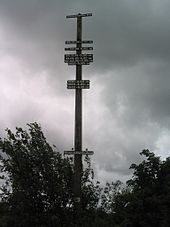Wilstermarsch
The Wilstermarsch is one of the four Holstein Elbe Marshes and is located northeast of the Elbe between its tributary Stör , the Kiel Canal and the Geestrand in the Steinburg district .
Settlements
Wilstermarsch is politically divided into the municipalities of the office of the same name Wilstermarsch and the city of Wilster , which does not belong to the official area but is its seat.
The Wilstermarsch office includes, among others, the church village of Sankt Margarethen and the municipality of Brokdorf , which has achieved national renown thanks to the Brokdorf nuclear power plant .
landscape
At 3.54 m below sea level, Neuendorf-Sachsenbande in Wilstermarsch is the lowest accessible point in Germany. The Wilsterau flows through the march ; It is drained among other things by the Große Feldwetter and the Kampritt weather . The landmark of the Wilstermarsch is the post mill in Honigfleth, which used to be used for drainage. There used to be around 350 such mills in the Wilstermarsch.
Land use
The marshland is still mainly used for agriculture, the most important branch being livestock, especially that of the Red Holstein lowland cattle . A well-known product is Wilstermarsch cheese .
Dairy farming and cheese production (similar to those in the Krempermarsch and on Eiderstedt ) were introduced by Dutch settlers who came to the Wilstermarsch at the beginning of the 12th century and again in the 16th century. With their experience and help, hundreds of drainage mills have been built to drain the largely sub-sea-level land.
Drainage of the marsh through a pumping station in Honigfleth. In 2010 an Archimedean snail was erected as a demonstration object.
See also
Web links
literature
- Count E. Reventlov : The Wilster March . With eight illustrations after photographs by Karl Kuskop. In: Vom Fels zum Meer 22nd vol., Vol. 2, 1903, pp. 1716–1718.
- Ruth Poppendieck: The Kremper and Wilstermarsch, their economic form and agricultural appearance , Lorenzen-Schmidt, Engelbrechtsche Wildnis 1986 (archive for agricultural history of the Holstein Elbmarschen. Supplement 2).
- Waldtraut Feldtmann: Das alten Brokdorf , Kommissionsverlag Karl Wachholtz, Neumünster, 1992, ISBN 3 529 027278 .






